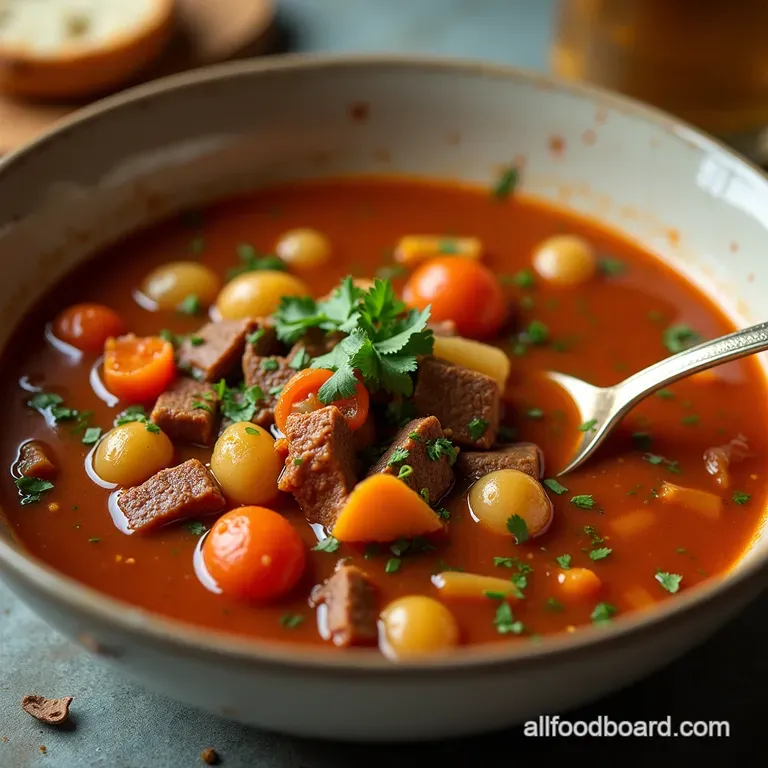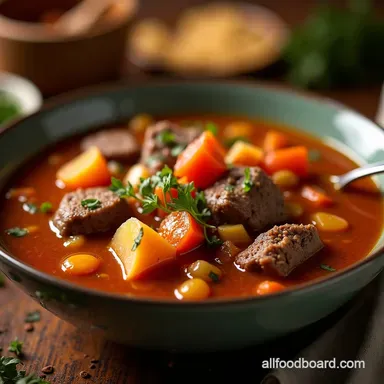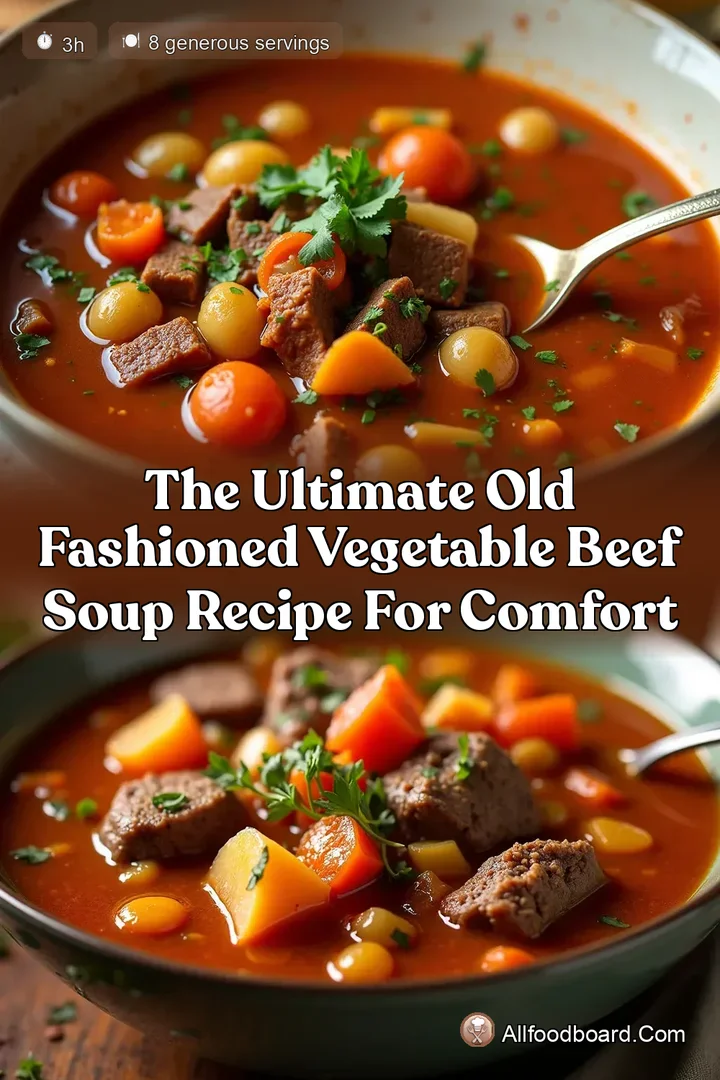Hearty Homestyle The Ultimate Old Fashioned Vegetable Beef Soup

- Why This Recipe Redefines Comfort Food: The Soul of Old Fashioned Vegetable Beef Soup
- The Secret to Deep, Savoury Broth (And Why We Skip the Canned Stuff)
- Assembling the Core Components for Robust Flavour
- The Method: Building Layers of Flavour Step-by-Step
- Achieving the Perfect Simmer Time for Tenderness
- Expert Answers: FAQ on Storage, Leftovers, and Variations
- Elevating the Experience: Serving Suggestions Beyond the Bowl
- Recipe FAQs
Old Fashioned Beef Soup

Instructions:
Nutrition Facts
Why This Recipe Redefines Comfort Food: The Soul of Old Fashioned Vegetable Beef Soup
There is a unique kind of warmth that settles deep in your bones when you encounter a truly magnificent bowl of Old Fashioned Vegetable Beef Soup . It isn't just a meal; it’s a memory—a culinary hug often reserved for blustery days or when life demands something grounding. Forget the thin, flavourless versions you sometimes encounter; this recipe is engineered to deliver the deep, rich essence of a pot that has been slowly tended all afternoon. We’re aiming for fork-tender beef chunks suspended in a savoury, beautifully coloured broth, studded with perfectly cooked root vegetables. This Easy Homemade Vegetable Beef Soup requires patience, but the payoff is unparalleled, delivering true, deep-seated comfort.
The Secret to Deep, Savoury Broth (And Why We Skip the Canned Stuff)
The hallmark of any great stew or hearty soup lies entirely in the quality and depth of its liquid base. A truly Old Fashioned Vegetable Beef Soup doesn't rely on canned condensed soup or artificial flavour boosters. Instead, we build the flavour sequentially, ensuring that every component—from the seared beef drippings to the wilted aromatics—contributes to a final broth that is complex and satisfying. Achieving this natural richness means dedicating time to the initial searing and allowing the low, slow simmer to extract all the goodness from the beef chuck.
A Nostalgic Promise: What Makes This Soup Truly Traditional
Tradition in this dish means using robust ingredients designed to withstand a long cooking process. We opt for beef chuck roast, cut into substantial cubes, which holds its texture beautifully while releasing collagen into the liquid, naturally thickening the soup without requiring heavy roux manipulation. On top of that,, the classic flavour profile avoids tomatoes entirely in many authentic regional variations, which is why this version focuses on Worcestershire sauce and root vegetables for umami—making this a superb Beef Vegetable Soup No Tomato approach that lets the savoury beef and fresh vegetables truly shine. This patient method ensures we capture the essence of a truly Old Fashioned Vegetable Beef Soup Recipe .
Setting the Scene: Tools Needed for Simmering Success
To execute this recipe successfully, the right equipment is non-negotiable. You will need a heavy-bottomed stockpot or, ideally, a Dutch oven. This heavy construction is crucial because it distributes heat evenly across the bottom, preventing scorching when you sauté your aromatics and ensuring the beef sears deeply rather than steaming. Since this soup cooks for nearly three hours, minimizing hot spots is key to achieving that flawless fond (the browned bits stuck to the bottom) that we will later scrape up to enrich the liquid base.
Beetroot Bonus: Incorporating Earthy Depth (Optional but Recommended)
While many recipes stick strictly to potatoes, carrots, and celery, a true enthusiast knows that a small addition of beetroot can elevate the earthiness. If you choose to include it, roughly 1/2 cup of diced beet, added at the same time as the potatoes, imparts a subtle, deep sweetness and a wonderfully rich hue to the broth. This slight tweak moves the profile toward a more rustic, old-world Vegetable Beef Soup With Cabbage style if you decide to add shredded cabbage later, offering complexity without overpowering the core flavour.
Assembling the Core Components for Robust Flavour
Before the heat goes on, organization is everything. The difference between a frantic cooking session and a calm simmer lies in having everything prepped and measured. For this recipe, yielding about 8 generous servings, we start with 2 pounds of beef chuck, cut into manageable 1-inch cubes. These cubes must be lightly dredged in flour mixed with salt and pepper, which not only seasons them but also provides the initial structure that helps the meat brown beautifully in the hot oil.
The Essential Beef Cut and Pre-Sear Technique
Beef chuck is the star here. It’s a tougher cut marbled with connective tissue that breaks down beautifully over low heat, yielding succulent, shreddable meat. The pre-sear is perhaps the single most important step in creating a deeply flavoured Old Fashioned Vegetable Beef Soup Recipe With Potatoes . You must cook the beef in batches in hot oil until a dark brown crust forms on every side—this is the Maillard reaction at work, creating hundreds of flavour compounds that cannot be replicated later. Do not overcrowd the pot; browning must happen quickly and intensely to achieve that foundational savoury base.
Selecting the Perfect Mirepoix and Aromatic Foundation
Once the beef is safely set aside, we build our aromatic foundation using the classic mirepoix: 1 large yellow onion, 3 carrots, and 3 celery stalks, all chopped uniformly. These are sautéed slowly in the residual beef fat, allowing them to soften and release their sugars, all while simultaneously dissolving the coveted browned fond from the bottom of the pot. After the vegetables have softened, we stir in 4 cloves of minced garlic, 2 tablespoons of tomato paste for concentrated sweetness, 1 teaspoon of dried thyme, and 1/2 teaspoon of crushed rosemary, letting them "bloom" in the heat for just one minute until intensely fragrant.
Stock vs. Broth: Choosing Your Liquid Gold
For liquid, we rely on 6 cups of quality beef broth. Always opt for low-sodium broth when cooking, as you will be adding salt throughout the process and reducing the liquid significantly. High-quality broth is crucial, as it forms the backbone of the entire dish. We will supplement this with one 14.5-ounce can of crushed tomatoes (even in our tomato-less variation, the crushed tomato adds necessary body and a touch of acidity), 1 tablespoon of Worcestershire sauce for deep umami, and 2 bay leaves to infuse subtle herbal notes throughout the long simmer.
Spice Rack Secrets: Enhancing the Old Fashioned Vegetable Beef Soup Profile
Beyond the foundational herbs of thyme and rosemary, keep the spice profile traditional and restrained. Overloading the spice cabinet can mask the delicate flavour of the slow-cooked beef and vegetables. A generous amount of freshly ground black pepper is essential, as is ensuring you have adequate salt throughout the layering process. This approach keeps the flavour clean, allowing the freshness of the final vegetables to shine through in this authentic Ground Beef Vegetable Soup style, even though we are using stew meat.
Related Recipes Worth Trying
- The Ultimate Ground Beef Vegetable Soup Recipe Easy Homestyle Dinner — Make this Hearty Beef Vegetable Soupa true hug in a bowl Its an easy homemade vegetable beef soup packed with flavour Get the foolproof steps here
- The Golden Crumb Easy Crispy Chicken Patties Recipe — Whip up these Easy Crispy Chicken Patties that are juicy inside and shatteringly crisp outside Perfect for quick chicken patties dinner inspiration Get the...
- The Golden Crunch Chicken Patties Juicy Inside Crispy — Say goodbye to soggy These Homemade Chicken Patties feature a doubledipped Panko crust that delivers ultimate crispness An easy weeknight chicken patties recipe
The Method: Building Layers of Flavour Step-by-Step

The beauty of this Easy Beef Vegetable Soup Stovetop method is its progressive nature. We assemble the base flavour first, then add the elements that require the longest cooking time, followed by those that need less.
- Browning and Setting Aside: After dusting the cubed beef chuck with flour, salt, and pepper, sear it in batches in 2 tablespoons of hot oil within your Dutch oven until deeply browned. Remove and reserve the meat.
- Building the Base: Reduce the heat slightly and add the diced onions, carrots, and celery to the pot, scraping up the fond as they soften over 6 to 8 minutes. Add the garlic, tomato paste, thyme, and rosemary, cooking for 60 seconds until fragrant.
- The First Simmer: Return the beef to the pot. Pour in the 6 cups of beef broth, the can of crushed tomatoes, Worcestershire sauce, and the bay leaves. Bring the mixture to a boil, then immediately reduce the heat until the surface is barely trembling—a very gentle simmer. Cover the pot tightly.
Achieving the Perfect Simmer Time for Tenderness
The initial simmer is where the magic happens for the protein. We must allow the connective tissues in the chuck roast to slowly dissolve into gelatin, which tenderizes the meat and enriches the surrounding liquid.
Browning the Beef: Creating the Maillard Reaction Foundation
As established, a dark, deep sear on the exterior of the beef cubes is non-negotiable. If the meat is only lightly greyed, your final broth will lack the foundational savoury depth required for a truly satisfying Old Fashioned Vegetable Beef Soup . Take your time here; this initial step is the foundation of the entire flavour structure.
The Sequential Addition of Vegetables for Optimal Texture
After the beef has simmered for a minimum of 1. 5 hours and is already showing signs of tenderizing, it is time to introduce the root vegetables. Add 1.5 pounds of peeled and cubed Russet potatoes. These starchy additions require approximately 30 to 40 minutes of simmering to become perfectly tender without turning to mush. This precise timing ensures you have distinct pieces of potato alongside the tender beef.
The Final Seasoning Check: Adjusting Salt and Acidity
Once the potatoes are tender, this is the critical juncture to taste the broth. Because the liquid has reduced, the flavours have intensified. Add salt and pepper incrementally until the broth sings. If it tastes slightly flat, a tiny dash more Worcestershire or a squeeze of lemon juice can brighten the entire pot, balancing the richness. Remove the bay leaves before proceeding. During the last five minutes, stir in 1 cup of frozen peas for a pop of colour and fresh sweetness.
Troubleshooting: When Your Soup Needs More Simmering Time
If, after the potato cooking time, the beef still offers significant resistance when pierced with a fork, do not panic. Continue the gentle simmer, covered, for another 20 to 30 minutes. Tough beef indicates insufficient breakdown time. Resist the urge to raise the heat; aggressive boiling will dry out the meat fibres. Low and slow always wins for developing fork-tender results in this Vegetable Beef Soup With Cabbage style preparation.
Expert Answers: FAQ on Storage, Leftovers, and Variations
Handling leftovers is a hallmark of a successful, large-batch soup like this Old Fashioned Vegetable Beef Soup Recipe . These dishes rarely taste better than they do the day after cooking.
Maximizing Freshness: How to Store This Classic Soup Properly
To store, allow the soup to cool to room temperature slightly before transferring it into airtight containers. Refrigerate promptly; it will keep beautifully for 4 to 5 days. The flavour deepens overnight as the starches from the potatoes slightly thicken the broth further. For longer storage, this soup freezes exceptionally well for up to three months. Thaw overnight in the refrigerator before reheating gently on the stovetop.
Recipe Twists: Integrating Root Vegetables Like Beets or Parsnips
While our primary structure uses classic carrots and potatoes, feel free to incorporate other root vegetables. Parsnips, with their slightly spicy sweetness, can be swapped in for half of the potatoes. If you include beets, remember they will tint the entire broth a deeper, reddish-brown hue, which is perfectly acceptable for a hearty stew. Experimenting with these additions can create interesting spins on the Old Fashioned Vegetable Beef Soup standard.
Frequently Asked Queries Regarding Cooking Times and Beef Shredding
A common question involves the beef texture. If you prefer shredded beef to cubes, simply allow the soup to simmer for an extra hour after the potatoes are tender (total simmer time around 3 hours). The beef will then pull apart effortlessly with two forks directly in the pot. If you are using Vegetable Beef Soup With Ground Beef , reduce the initial simmering time by about 45 minutes, as ground meat cooks much faster than stewing chunks.
Pairing Perfection: What Bread or Garnish Completes Your Meal?
This soup is rich enough to stand alone, but serving it with a substantial accompaniment elevates the meal. The best pairing is a thick slice of crusty sourdough bread, perfect for soaking up every last drop of the savoury broth. Alternatively, a slightly sweet Irish Soda Bread provides a delightful textural contrast. Finish every bowl with a generous sprinkle of fresh, bright parsley to cut through the richness.
Elevating the Experience: Serving Suggestions Beyond the Bowl
Serving your beautiful Old Fashioned Vegetable Beef Soup requires only minimal fuss, as the dish is already deeply satisfying. However, a few simple additions can transform it from a simple supper into a truly memorable event.
Recipe Twists: Integrating Root Vegetables Like Beets or Parsnips
For those seeking a more robust profile, consider adding a half cup of pearl barley or quick-cooking farro along with the potatoes. These grains absorb the broth beautifully, adding an extra dimension of chewiness and nutritional heft, turning this into an even heartier Easy Beef Vegetable Soup Stovetop preparation for a main course.
Frequently Asked Queries Regarding Cooking Times and Beef Shredding
If you find your broth seems thin, even after the potatoes have softened, you can create a simple slurry by whisking one tablespoon of cornstarch with two tablespoons of cold water. Stir this mixture slowly into the gently simmering soup until it reaches your desired thickness. This technique is often necessary if you used a lighter broth to begin with when preparing your Ground Beef Vegetable Soup base.
Pairing Perfection: What Bread or Garnish Completes Your Meal?
While fresh parsley is the standard garnish, don't overlook a dollop of good, full-fat sour cream or créme fraîche swirled on top just before serving. The slight tang provides a beautiful counterpoint to the rich, savoury depth developed throughout the long simmering process, completing the classic experience of this wonderful Old Fashioned Vegetable Beef Soup Recipe .

Recipe FAQs
How can I make sure my beef in this Old Fashioned Vegetable Beef Soup is really tender?
The secret is patience, mate! You must sear the meat well first, and then allow it to simmer very gently for at least 1.5 hours before adding the potatoes. If you rush it or boil it too fiercely, the beef will seize up and get tough. Think "low and slow," just like a proper Sunday roast.
My broth seems a bit thin; what’s the best way to thicken it without making it gloopy?
If you’ve followed the recipe, the flour coating on the beef should provide some natural thickening, but sometimes it needs a boost. For a quick fix, mix a teaspoon of cornstarch with two teaspoons of cold water (a slurry) until smooth, then whisk it slowly into the simmering soup. Let it bubble for 5 minutes, and it should thicken up nicely.
Can I use frozen vegetables instead of fresh for this soup?
You absolutely can, especially for convenience! You can substitute frozen carrots, celery, and even potatoes (though frozen potatoes can sometimes get a bit mushy). If you use frozen mixed vegetables, add them right at the end, only 5-10 minutes before serving, so they don't turn to complete mush during the long simmer.
Is this soup alright for eating the next day, or should it be eaten fresh?
Honestly, this soup is leagues better on day two! Once cooled and refrigerated overnight, all those deep, savoury flavours meld together beautifully, making it taste richer and more developed. Just reheat gently on the hob—it’s the perfect ready-made lunch for the following day.
I don't have beef broth; what's a good substitute for the liquid base?
If you’re fresh out of beef broth, high-quality vegetable stock is a decent stand-in, but you’ll lose some of that rich, meaty flavour. To compensate, I recommend stirring in a spoonful of Marmite or a dash of Worcestershire sauce to boost the umami depth lost by swapping the beef stock.